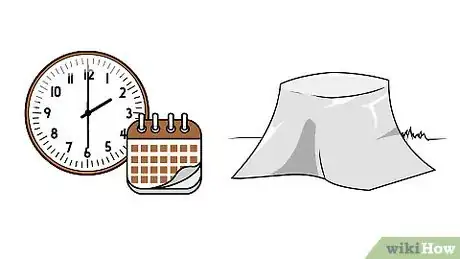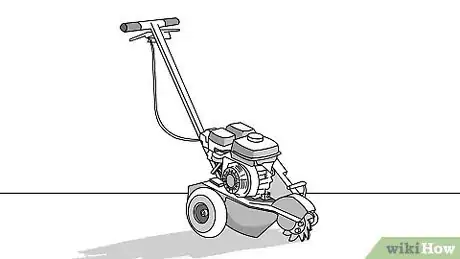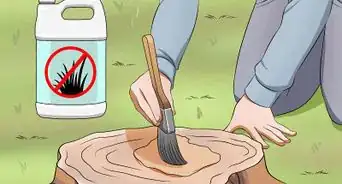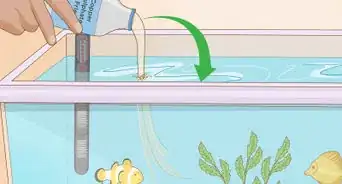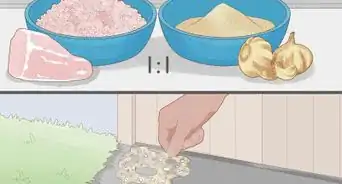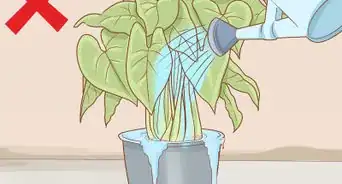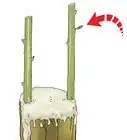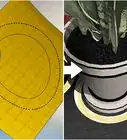This article was co-authored by Andrew Carberry, MPH. Andrew Carberry is a Food Systems Expert and the Senior Program Associate at the Wallace Centere at Winrock International in Little Rock, Arkansas. He has worked in food systems since 2008 and has experience working on farm-to-school projects, food safety programs, and working with local and state coalitions in Arkansas. He is a graduate of the College of William and Mary and holds a Masters degree in public health and nutrition from the University of Tennessee.
wikiHow marks an article as reader-approved once it receives enough positive feedback. This article received 19 testimonials and 90% of readers who voted found it helpful, earning it our reader-approved status.
This article has been viewed 1,304,807 times.
If you have a tree stump in your yard that’s producing new shoots, you’ve got to kill it or it may just keep growing. A half-dead tree stump is an unsightly obstacle that won’t go away on its own. You can kill a stump by using a salt solution or shielding it from the sun. Then, you can remove the dead stump by burning it or chopping it up.
Steps
Using Epsom or Rock Salt
-
1Obtain Epsom salt or rock salt. Using Epsom salt or rock salt is an easy way to kill a stump cheaply. When you use the salt method it takes several months for the stump to die, so it might not be your best bet if you need to get rid of the stump quickly.
- You can find options for Epsom salt on Amazon here and rock salt here.
- Do not use regular table salt, which is harmful to the soil surrounding the stump. Use 100 percent Epsom or rock salt with no added ingredients, to make sure the land around the stump doesn't get disturbed.
- For a stubborn stump you can try a chemical stump remover or an herbicide containing glyphosate or triclopyr instead of salt.[1] While a chemical herbicide will kill the stump faster, keep in mind that it could kill the roots of surrounding trees or shrubs as well. Please note: The WHO considers glyphosate to be a probable human carcinogen. Its use is prohibited in some states and countries. Please check with your local laws and use caution if handling this chemical.
-
2Drill holes in the stump. Drill a pattern of holes across the surface of the stump, so the solution will be able to penetrate. The holes should be about 1⁄2 to 1 inch (1.3 to 2.5 cm) wide and at least 8 inches (20.3 cm) deep, or 12 inches (30.5 cm) if you have a long enough drill bit. Penetrating deeply will ensure the salt solution saturates the roots below the trunk.[2]
- If you don't have a drill bit this long, use an ax to chop into the wood and make gouges as deep as you can. Alternatively, you can find long drill bits on Amazon here.
- If you're working with a stump that has large arial roots, drill holes in those as well.
Advertisement -
3Pack the holes with salt and top them off with wax. Fill up the holes 3/4 full with epsom salt or rock salt. Don't forget the holes you drilled in the arial roots. Now light a plain, unscented candle like these and drop wax into the holes to plug them.
- It's important to make sure the salt stays in place, rather than scattering over your yard, since excess salt can be harmful to topsoil and the roots of other plants.
-
4Cover the stump. Put a plastic tarp, trash bag or another nonporous item over the stump to cover it. It will die more quickly without sunlight and rain to continue nourishing any shoots that come up. After six weeks to several months the stump will die. Check it every once in a while to see how things are progressing. When the stump is dead, it should begin falling apart on its own.
Shielding it from the Sun
-
1Cover the stump. This method can be free, but can take a long time. The idea is to slowly kill the stump by denying its basic needs. Put a dark tarp or trash bag over the stump so it won’t receive sun or water.
-
2Wait three to six months. During this time, the stump will slowly die. Check it from time to time to see how things are progressing. It should begin to rot and fall apart.
- As it dies and rots, you can use stump removal solution to speed the process along. It's available at nurseries and garden centers.
- You can also add some Epsom salt to cracks that appear in the stump, or see Method One and drill holes in the stump and fill them with salt to make it go faster.
-
3Cut off any saplings that crop up. Covering the stump should prevent anything from growing, but until the stump is dead, you can cut saplings off the base of the trunk as they sprout, or paint them with a woody brush killer that contains triclopyr. If your goal is to allow one tree to grow from the old stump, cut off additional saplings and do not apply an herbicide.
Burning the Stump
-
1Drill holes in the stump. Burning is a good way to remove the stump after you have killed it. Start by drilling plenty of holes across the surface of the stump. The holes should be about 1⁄2 to 1 inch (1.3 to 2.5 cm) wide and at least 8 inches (20.3 cm) deep, or 12 inches (30.5 cm) if you have a long enough drill bit. Penetrating deeply will ensure the stump gets burned down to the tips of the roots so that it will be easy to remove.[3]
-
2Pour kerosene into the holes. Soaking the stump with kerosene will enable you to light it on fire so it will burn into ash. Make sure the stump is fully saturated, or the fire may go out before it reaches the tips of the roots.
- Another option is to place charcoal on top of the stump and light the charcoal on fire. The coals will slowly burn down through the stump. This method will reduce the chances of burning nearby plants.
- If you're worried about nearby objects catching fire, you shouldn't use this method. You're going to be setting the stump on fire, and while it's quite effective, it can be dangerous if you don't have plenty of room around the stump.
- Check local city ordinances to make sure it’s legal to do a controlled burn. Call 411 to find out more information.
-
3Build a fire on top of the stump. Put scrap wood on top of the stump and use a fire starter to ignite it. As the fire burns down, the stump will catch and burn up. Look closely to make sure the stump actually catches, and add more wood as necessary to keep the fire going.[4]
- Be sure to monitor the stump as it burns to ash. Don’t leave it unattended, in case the fire gets out of hand.
- Depending on the size of the stump, the burn may take several hours.
-
4Dig out the ashes and fill in the hole. Use a shovel to remove all of the ashes, down through where the roots were, and fill in the hole with fresh soil.
Chopping it Up
-
1Get a stump grinder. You can also chop up a stump to remove it. To use this removal method, you will need a stump grinder. You can rent one from a home improvement store. This machine has a rotary cutter that will drill into and grind up the stump. It's a good method to use if you have a huge, stubborn stump you need to remove. Renting a stump grinder is probably the most prudent option, but if you have a lot of stumps to grind, it might be worth it to buy one.[5]
- Get protective equipment, too. Goggles and a mask will protect you from sawdust and flying wood chips.
- If you don't enjoy handling heavy machinery, call a local landscaper and explain that you have a stump that needs to be removed. You'll be able to pay someone else to do it.
-
2
-
3Grind up the stump. Put on your goggles and mask, and position the stump grinder over the stump. Then, following the manufacturer’s instruction, move the grinder slowly across the stump's surface to grind it up to bits. Continue along the arial roots to grind those as well until the stump has been fully ground up.
- Be careful not to get your feet in the way of the grinder. Wear heavy boots so you won't accidentally hurt yourself.
- Make sure children and pets are safely away from the equipment before you begin operating it.
-
4Shovel out the grindings and fill in the hole. Remove all of the wood chips and discard them (or use them as mulch), then fill in the hole with soil.
- You might need to use an ax to chop out remaining roots.
Community Q&A
-
QuestionCan I kill a stump using herbicide?
 Andrew Carberry, MPHAndrew Carberry is a Food Systems Expert and the Senior Program Associate at the Wallace Centere at Winrock International in Little Rock, Arkansas. He has worked in food systems since 2008 and has experience working on farm-to-school projects, food safety programs, and working with local and state coalitions in Arkansas. He is a graduate of the College of William and Mary and holds a Masters degree in public health and nutrition from the University of Tennessee.
Andrew Carberry, MPHAndrew Carberry is a Food Systems Expert and the Senior Program Associate at the Wallace Centere at Winrock International in Little Rock, Arkansas. He has worked in food systems since 2008 and has experience working on farm-to-school projects, food safety programs, and working with local and state coalitions in Arkansas. He is a graduate of the College of William and Mary and holds a Masters degree in public health and nutrition from the University of Tennessee.
Food Systems Expert Herbicide would have to be applied just after the tree is cut down, before the wounds close up. Carefully paint herbicide on the stump, focusing on the outer rings/cambium layer.
Herbicide would have to be applied just after the tree is cut down, before the wounds close up. Carefully paint herbicide on the stump, focusing on the outer rings/cambium layer. -
QuestionHow can I kill a tree stump that is close to a lake on my property?
 Andrew Carberry, MPHAndrew Carberry is a Food Systems Expert and the Senior Program Associate at the Wallace Centere at Winrock International in Little Rock, Arkansas. He has worked in food systems since 2008 and has experience working on farm-to-school projects, food safety programs, and working with local and state coalitions in Arkansas. He is a graduate of the College of William and Mary and holds a Masters degree in public health and nutrition from the University of Tennessee.
Andrew Carberry, MPHAndrew Carberry is a Food Systems Expert and the Senior Program Associate at the Wallace Centere at Winrock International in Little Rock, Arkansas. He has worked in food systems since 2008 and has experience working on farm-to-school projects, food safety programs, and working with local and state coalitions in Arkansas. He is a graduate of the College of William and Mary and holds a Masters degree in public health and nutrition from the University of Tennessee.
Food Systems Expert The safest way to to do this would be to periodically cut back any growth on the stump. You wouldn't want to use kerosene so close to a lake.
The safest way to to do this would be to periodically cut back any growth on the stump. You wouldn't want to use kerosene so close to a lake. -
QuestionWhy would anyone want to kill a tree?
 Community AnswerIt may be a hazard to your house, or the roots are busting a water and/or sewer line.
Community AnswerIt may be a hazard to your house, or the roots are busting a water and/or sewer line.
Warnings
- Trees that grow close together, especially if they are of the same species, develop a network of roots that sometimes share vascular tissue through a process known as root grafting. If trees have developed root grafting, herbicides applied to the stump of one tree will pass to the other trees.⧼thumbs_response⧽
- You may need to take other precautions if sprouts still develop after you grind the stump down, as some hardy trees can still sprout growth from the remaining stump.⧼thumbs_response⧽
- Even if tree roots are not grafted, they may release some of the herbicide into the soil through their root network. Once the herbicides are released into the environment, all surrounding plant life may absorb it.⧼thumbs_response⧽
References
- ↑ http://forums2.gardenweb.com/forums/load/trees/msg011804592087.html
- ↑ http://forums2.gardenweb.com/forums/load/organic/msg051819595723.html?8
- ↑ http://www.familyhandyman.com/landscaping/how-to-remove-a-tree-stump-painlessly/view-all
- ↑ http://forums2.gardenweb.com/forums/load/organic/msg051819595723.html?8
- ↑ http://www.popularmechanics.com/home/improvement/lawn-garden/1273711
- ↑ http://www.popularmechanics.com/home/improvement/lawn-garden/1273711
About This Article
To kill a tree stump, start by drilling holes across the top of the stump that are at least 8 inches deep. Then, fill up the holes with Epsom salts or rock salts and seal them shut with melted candle wax. Once you've filled and sealed all of the holes, cover the stump with a plastic tarp or trash bag and wait at least 6 weeks for the stump to die. If you're in a rush to kill the stump, fill the holes with kerosene instead of salt and then build a fire on top of the stump. Once the entire stump has burned down, remove the ashes and fill in the leftover hole. For more tips from our Gardener reviewer, including how to chop the stump into pieces or shield it from the sun and let shade kill it for you, read on!

